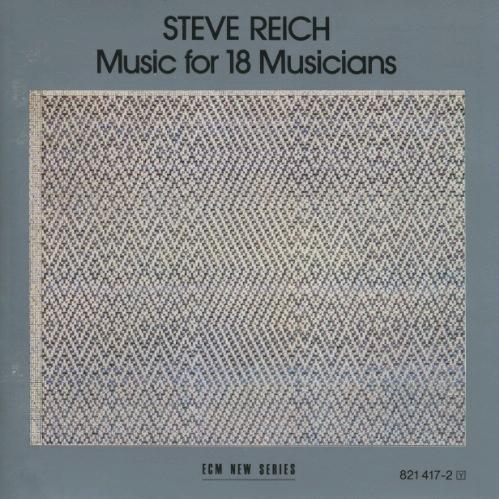Steve Reich Music for 18 Musicians Review Eighth Blackbird
Tonight at Millennium Park at six:xxx, the outstanding local new-music ensemble Eighth Blackbird plays Steve Reich's Double Sextet, the Pulitzer-winning piece they commissioned from the veteran minimalist composer, along with his classic Music for eighteen Musicians. The complaint about minimalism is that it tin sound a flake samey, so this pairing of works should provide a skillful comparison beyond Reich'due south career and contrast across his compositional styles.
Reich likes to make rhythmic music of considerable density, and Eighth Blackbird is a small ensemble that was almost too small for Reich, to the extent that he virtually didn't have their commission:
I said, "Gee, I've heard of them—what'south their instrumentation?" She replied, "Well, one flute, one clarinet, one violin, one cello, piano, percussion." I said, "Jenny, I can't write for that." Pierrot plus percussion, we call that.
[snip]
For me, instrumentation is inspiration, because I invent my ensembles. I'm non writing for a string quartet, I'm writing for three string quartets. I'm not writing for Pierrot plus percussion, I'm writing for this double sextet. So getting the instruments right is really what gets me going.
Reich'due south solution was to take the ensemble play against a recording of itself, just the piece is still more open and airy than much of his before piece of work. The second movement in particular, 2. Slow half dozen:43, is an eerie, fragile, almost ambient sound that relies heavily on unnerving woodwinds.
It's a warm, analog piece in comparison to the 35-year-former Music for 18 Musicians which, despite being written for acoustic instruments, has always felt digital to me, thanks to its pulsating rhythms. Reich explains how it works in his notes to the score:
Rhythmically, there are two basically dissimilar kinds of time occurring simultaneously in Music for 18 Musicians. The first is that of a regular rhythmic pulse in the pianos and mallet instruments that continues throughout the piece. The second is the rhythm of the man jiff in the voices and wind instruments. The unabridged opening and endmost sections plus part of all sections in between incorporate pulses by the voice and winds. They take a full breath and sing or play pulses of particular notes for equally long as their jiff will comfortably sustain them. The breath is the measure out of the duration of their pulsing. This combination of ane breath after some other gradually washing upwardly like waves against the constant rhythm of the pianos and mallet instruments is something I have non heard before and would like to investigate farther.
Music for xviii Musicians was the offset "new music" piece I e'er heard. I was initially attracted by the encompass, which looked like a dot-matrix blanket. Turns out I wasn't far off:
"Only as the spinning and gathering of wool serve equally the raw material for a weave, so the artist working with video selects images to serve as the basic substance of the work." For most of the 1980s, Korot concentrated on a series of paintings that were based on a language she created that was an analogue to the Latin alphabet. Drawing on her before interest in weaving and video as related technologies, she made almost of these paintings on manus-woven and traditional linen sail.

I came to Reich'due south piece in the early days of the Web, when I was still figuring out computers, and it will always represent that time for me, when I was learning how the digital world emerged out of and fed back into the real world. What instrumental music "ways" is a catchy and oftentimes dumb question, hence the one-time saw of "dancing nigh architecture," simply Music for 18 Musicians sounded to me similar that earth beingness created. If you've seen Terrence Malick'due south The New World, you might retrieve the opening, in which John Smith discovers the "new world" to the layered strains of the prelude to Das Rheingold:
That's what Music for 18 Musicians brings forth inside my head, only the new world was a virtual one.
I was living in rural Virginia at the fourth dimension, and it also sounded like the city, or what the internal life of the metropolis might sound like every bit converted to music. Think of the chooga-chooga beat behind Johnny Greenbacks's train songs then much other country and rockabilly, and how that emerges out of the landscape, and imagine that coming out of the city. As Alex Ross wrote of Reich in The Rest Is Noise:
He reacts swiftly to slight sounds in his midst—the soft buzz of a jail cell phone, a siren on the street outside, the whistle of a teakettle. Each sound contains information. The 1995 piece of work City Life conveys what it would exist like to experience the world through Reich'southward ears: the subconscious melodies of overheard conversations and the rhythms of pile drivers cook together into a smoothly flowing v-movement composition, a digital symphony of the street.
City Life, with car horns, closing doors, and hissing steam sneaking out between the percussive music, sounds more than like an actual city, but I hadn't lived in ane then, and my abstract formulation of information technology, a filigree of information every bit much equally streets and tracks and wires, was Music for 18 Musicians.
I wink dorsum to Reich'south music whenever I'm at Union Station waiting for the Metra, where the track location announcements, meant to assist the blind, overlap in a minimalist cacophony: near like the city paying tribute back to Reich and his contemporaries.
Source: https://www.chicagomag.com/city-life/august-2011/eighth-blackbird-plays-steve-reich-pulitzer-winning-double-sextet/
0 Response to "Steve Reich Music for 18 Musicians Review Eighth Blackbird"
Post a Comment